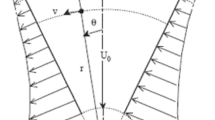Abstract
This study shows that fully developed pipe flow of a particulate suspension is defined by four dimensionless parameters of particle-fluid interactions in addition to the Reynolds number. Effects accounted for include the Magnus effect due to fluid shear, electrostatic repulsion due to electric charges on the particles, and Brownian or turbulent diffusion. In the case of a laminar liquid-solid suspension, electrostatic effect is negligible but shear effect is prominent. Solution of the basic equations gives the density distribution of particles with a peak at the center (Einstein, Jeffery) or at other radii between the center and the pipe wall (Segré et al) depending on the magnitudes of the various flow parameters. In the case of a turbulent gas-solid suspension, the Magnus effect is significant only within the thickness of the laminar sublayer. However, charges induced on the particles by the impact of particles at the wall produce a higher density at the wall than at the center of the pipe. The velocity distribution of particles is characterized by a slip velocity at the wall and a lag in velocity in the core from the fluid phase. These results are verified by earlier measurements.
Similar content being viewed by others
References
Einstein, A., Ann. Physik (Leipzig) 19 (1906) 289.
Jeffery, G. B., Proc. Roy. Soc. (London) A 102 (1922) 161.
Segré, G. and A. Silberberg, Nature 189 (1961) 209; J. Fluid Mech. 14 (1962) 115, 136.
Soo, S. L., G. J. Trezek, R. C. Dimick, and G. F. Hohnstreiter, Ind. Eng. Chem. Fund. 3 (1964) 98.
Soo, S. L. and G. J. Trezek, Ind. Eng. Chem. Fund. 5 (1966) 388.
Schlichting, H., Boundary Layer Theory, pp. 11, 464, 504, 506, McGraw-Hill, New York 1960.
Hinze, J. O., Turbulence, p. 24, McGraw-Hill, New York 1959.
Soo, S. L., Chem. Eng. Sci. 5 (1956) 57.
Soo, S. L., Fluid Dynamics of Multiphase Systems, pp. 16, 33, 46, 76, 176, 200, 256, 262, 263, Blaisdell, Publ. Co. Waltham (Mass.) 1967.
Soo, S. L., Ind. Eng. Chem. Fund. 3 (1964) 75.
Hinze, J. O., Appl. Sci. Res. A 11 (1962) 33.
Soo, S. L., Non-Equilibrium Fluid Dynamics-Flow over a Flat Plate, ZAMP, in press, 1968.
Soo, S. L., Proc. Symp. on Interactions between Fluids and Particles, p. 50, Inst. Chem. Engrs., London 1962; Ind. Eng. Chem. Fund. 4 (1965) 426.
Saffmann, P. G., J. Fluid Mech. 22 (1965) 385.
Daily, J. W. and G. Bugliarello, Ind. Eng. Chem. 51 (1959) 887.
Pfeffer, R., S. Rossetti, and S. Lieblein, NASA TN D-3603, NASA, Washington (D.C.) 1966.
Author information
Authors and Affiliations
Rights and permissions
About this article
Cite this article
Soo, S.L. Pipe flow of suspensions. Appl. sci. Res. 21, 68–84 (1969). https://doi.org/10.1007/BF00411597
Received:
Revised:
Issue Date:
DOI: https://doi.org/10.1007/BF00411597




